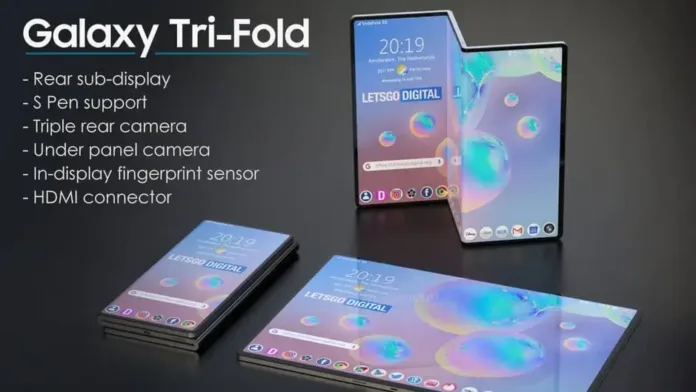Table of Contents
Samsung has finally unveiled its long-rumored Galaxy Z TriFold, the company’s most ambitious foldable yet.
At the Asia-Pacific Economic Cooperation (APEC) summit in Gyeongju, South Korea, on October 29 2025, the device appeared publicly behind a transparent showcase. This confirmed months of leaks, signaling that the world’s first commercially available dual-hinge tri-fold phone is nearly ready for release. What this really means is Samsung is not just refining the Z Fold, it’s establishing a new, ultra-premium category.
Read more on our article of, 8 Samsung One UI 8.5 Features That Will Transform Galaxy Phones, pulished on September 23rd 2025, SquaredTech.
Innovative Folding Display and Dual-Hinge Design
The Galaxy Z TriFold uses an inward-folding, dual-hinge mechanism that lets both panels close toward the center. Folded, it feels like a standard smartphone with a 6.5-inch display;opened, it expands to a proper10-inch tablet-class screen. That design protects the inner panels and critically reduces wear on the flexible glass—a lesson learned from years of Z Fold development.
Samsung confirmed the prototype shown at APEC runs on dual 120 Hz AMOLED panels with HDR10+ certification and a peak brightness of ≈ 2,200 nits, matching Galaxy S24 Ultra levels. The crease — once a hallmark flaw of early foldables — is now barely visible thanks to new hinge geometry and tighter ultra-thin-glass layering.
Inside, the TriFold houses a three-cell 4,400 mAh battery supporting 45 W fast charging. Let’s break down the engineering here: Each battery segment powers its respective display panel, keeping thermal balance consistent across folds. This segmented charging logic, hinted at in early patents, is designed to prevent localized heat buildup during heavy use.
The rear camera array mirrors Samsung’s flagship setup: a 50 MP main, 12 MP ultra-wide, and 10 MP telephoto system adapted from the S24 Ultra. That gives the TriFold full flagship optics rather than the downgraded cameras often seen in foldables.
Refined Software: The Power of Spatial Multitasking
Hardware is only half the story. The TriFold debuts One UI 8.5 with Flex Canvas, Samsung’s new interface optimized for multi-fold layouts.
Apps remain anchored as the device folds or unfolds, while multi-window continuity allows drag-and-drop actions across panels—for example, moving a photo from a chat into a presentation in one motion. Samsung’s engineers describe Flex Canvas as “spatial multitasking”, a perfect phrase designed to make the device feel less like a novelty and more like a small, portable workstation.
TriFold vs. The Competition: A Quick Data Breakdown
| Feature | Samsung Galaxy S25 Ultra (Slab Phone) | Samsung Galaxy Tab S11 (Tablet) | Galaxy Z TriFold (Multi-Fold Flagship) |
| Price (Estimated) | $1,300 | $800 | $2,999 |
| Folded Screen Size | 6.8 Inches | N/A | 6.5 Inches (Smartphone Mode) |
| Unfolded Screen Size | N/A | 11 Inches | 10 Inches (Tablet Mode) |
| Hinges | None | None | Dual-Hinge Mechanism |
| Max Thickness (Open) | 8.9 mm | 6.5 mm | 4.2 mm (Stunningly Thin) |
| Battery Capacity | 5,000 mAh | 8,000 mAh | 4,400 mAh (Three-Cell System) |
| Key Advantage | Durability, Single Slab Simplicity | Pure Screen Real Estate | Flexibility: Phone, Tablet, Workstation |
Naming Controversies and Release Plans
While some early leaks called it the “Galaxy G Fold”, Samsung’s Mobile Experience chief TM Roh confirmed that the working name remains Galaxy Z TriFold to stay consistent with the Z-series branding.
The TriFold’s official retail window is November 2025, with a launch price around US $2,999 for the 128 GB base model. Production is limited to roughly 50,000 units for the first run, making it one of Samsung’s most exclusive launches yet. The high cost and limited volume reflect the company’s measured approach — testing consumer demand before scaling production in 2026.
Market Availability and Geographic Launch Focus
Samsung’s first release wave will focus on Asia-Pacific markets: South Korea, China, Singapore, Taiwan, and the UAE.
Executives told local media the goal is to gather durability and usability feedback from regions most familiar with foldables.
New certification filings spotted in early November by Notebookcheck reveal a global Galaxy Z TriFold model approved for the EU, hinting that wider distribution could follow sooner than expected. If tests go smoothly, Europe — and possibly North America — may see availability in early 2026.
Analysts say this limited rollout mirrors Samsung’s 2019 strategy with the first Galaxy Fold: start small, prove reliability, then expand fast. It also helps Samsung maintain quality control on the world’s most complex smartphone hinge to date.
Final Thoughts on the Galaxy TriFold
The TriFold arrives at a time when the foldable market needs its next breakthrough. Competitors like Huawei’s Mate XT and Honor’s Magic V Purse have shown multi-panel prototypes, but none reached commercial maturity.
Samsung’s advantage lies in years of hinge testing, repair network experience, and global marketing muscle. Industry observers see the TriFold as both a flagship experiment and a category test — a device aimed at early adopters, creators, and professionals rather than the mass market. If it performs well, expect competitors like Xiaomi and Oppo to revisit their tri-fold concepts.
The Galaxy Z TriFold is not just another foldable — it’s Samsung’s statement that mobile devices can evolve into adaptable, multi-form computers.
Its dual 120 Hz displays, Flex Canvas software, and flagship-grade camera push the boundaries of what’s practical in a pocket-sized form factor. At $2,999, it’s a niche product for now, but it sets a template for the next generation of foldables.
If Samsung can prove durability and deliver consistent software refinement, the TriFold could become the benchmark for multi-fold designs in 2026 — or, at the very least, the phone that made tri-folds real.
Stay Updated: Mobile


